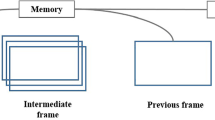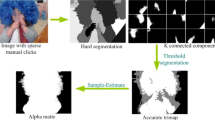Abstract
Image matting is an important task in image and video editing. In this paper we propose a novel automatic matting approach, which can provide a good set of constraints without human intervention. We use the attention shift trace in a temporal sequence as the useful constraints for matting algorithm instead of user-specified “scribbles”. Then we propose a modified visual selective attention mechanism which considered two Gestalt rules (proximity & similarity) for shifting the processing focus. Experimental results on real-world data show that the constraints are useful. Distinct from previous approaches, the algorithm presents the advantage of being biologically plausible.
Access this chapter
Tax calculation will be finalised at checkout
Purchases are for personal use only
Preview
Unable to display preview. Download preview PDF.
Similar content being viewed by others
References
Apolstoloff, N., Fitzgibbon, A.: Bayesian Video Matting Using Learnt Image Priors. In: 2004 IEEE Computer Society Conference on Computer Vision and Pattern Recognition, Washington, vol. 1, pp. 407–414 (2004)
Bai, X., Sapiro, G.: A Geodesic Framework for Fast Interactive Image and Video Segmentation and Matting. In: 11th IEEE International Conference on Computer Vision, Rio De Janeiro, pp. 1–8 (2007)
Chuang, Y., Curless, B., Salesin, D., Szeliski, R.: A Bayesian Approach to Digital Matting. In: 2001 IEEE Computer Society Conference on Computer Vision and Pattern Recognition, Hawaii, vol. II, pp. 264–271 (2001)
Levin, A., Lischinski, D., Weiss, Y.: A Closed Form Solution to Natural Image Matting. In: 2006 IEEE Computer Society Conference on Computer Vision and Pattern Recognition, New York, vol. 1, pp. 61–68 (2006)
Rhemann, C., Rother, C., Gelautz, M.: Improving Color Modeling for Alpha Matting. In: British Machine Vision Conference 2008, Leeds, pp. 1155–1164 (2008)
Wang, J., Cohen, M.: An Iterative Optimization Approach for Unified Image Segmentation and Matting. In: 10th IEEE International Conference on Computer Vision, Beijing, vol. 2, pp. 936–943 (2005)
Apostoloff, N., Fitzgibbon, A.: Automatic Video Segmentation Using Spatiotemporal T-junctions. In: British Machine Vision Conference 2006, Edinburgh, pp. 1–10 (2006)
Tsotsos, J.K., Culhane, S.M., Wai, W., Lai, Y.H., Davis, N., Nuflo, F.: Modeling Visual Attention via Selective Tuning. Artificial Intelligence 78, 507–545 (1995)
Itti, L., Koch, C.: Computational Modelling of Visual Attention. Nature Reviews Neuroscience (2001)
Walther, D., Koch, C.: Modeling Attention to Salient Proto-objects. Neural Networks 19, 1395–1407 (2006)
Li, M., Clark, J.J.: Selective Attention in the Learning of Invariant Representation of Objects. In: 2005 IEEE Computer Society International Conference on Computer Vision and Pattern Recognition, San Diego, vol. 3, pp. 93–101 (2005)
Posner, M.I.: Orienting of Attention. Quat. J. Exper. Psych. 32, 2–25 (1980)
Walther, D., Itti, L., Riesenhuber, M., Poggio, T., Koch, C.: Attentional Selection for Object Recognition – a Gentle Way. In: Bülthoff, H.H., Lee, S.-W., Poggio, T.A., Wallraven, C. (eds.) BMCV 2002. LNCS, vol. 2525, pp. 472–479. Springer, Heidelberg (2002a)
Author information
Authors and Affiliations
Editor information
Editors and Affiliations
Rights and permissions
Copyright information
© 2010 Springer-Verlag Berlin Heidelberg
About this paper
Cite this paper
Sun, W., Luo, S., Wu, L. (2010). A Biologically-Inspired Automatic Matting Method Based on Visual Attention. In: Zhang, L., Lu, BL., Kwok, J. (eds) Advances in Neural Networks - ISNN 2010. ISNN 2010. Lecture Notes in Computer Science, vol 6064. Springer, Berlin, Heidelberg. https://doi.org/10.1007/978-3-642-13318-3_22
Download citation
DOI: https://doi.org/10.1007/978-3-642-13318-3_22
Publisher Name: Springer, Berlin, Heidelberg
Print ISBN: 978-3-642-13317-6
Online ISBN: 978-3-642-13318-3
eBook Packages: Computer ScienceComputer Science (R0)




